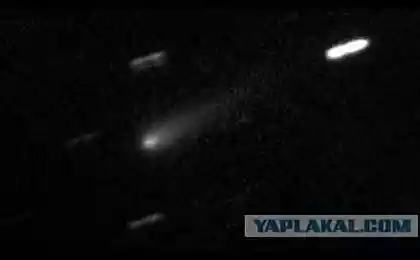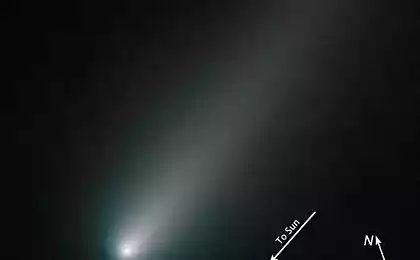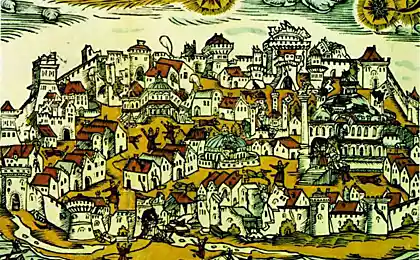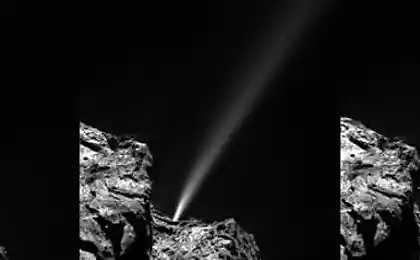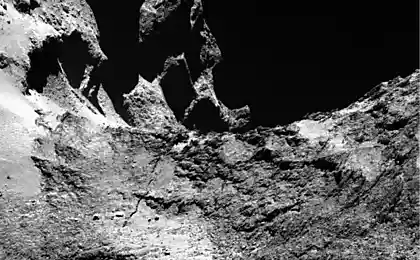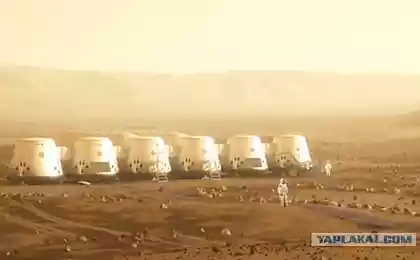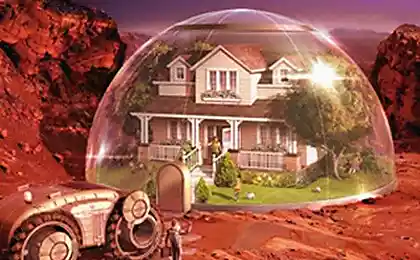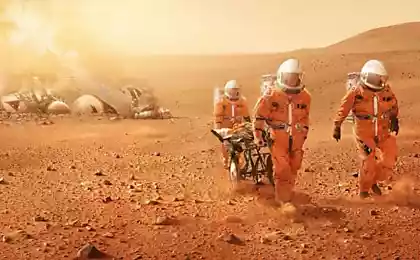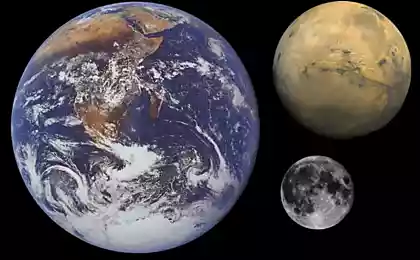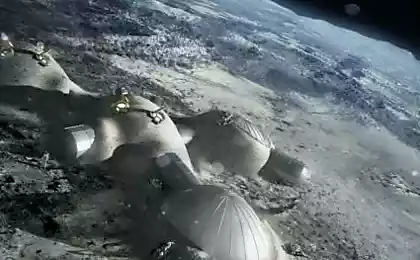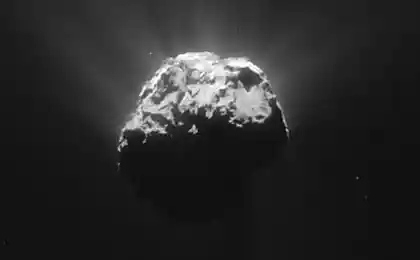1931
Rosetta - the most interesting space mission in 2014
In 2014, in the solar system occur two exciting events that stand out. Ironically, they both are associated with comets. Now tell you about one of them.
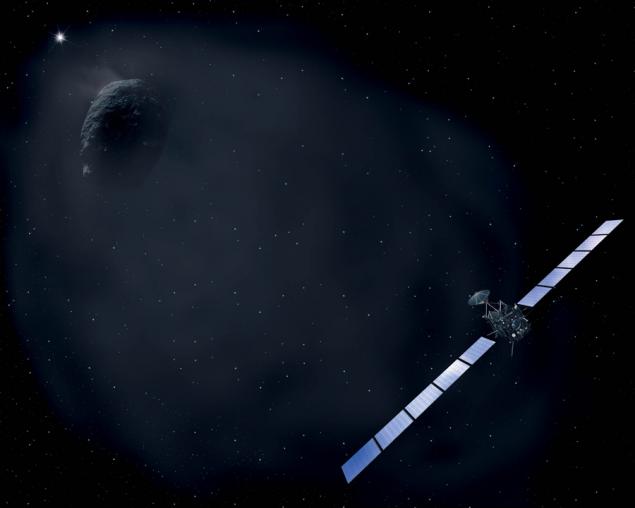
This summer and fall in space held the culmination of one of the most interesting research operations that are comparable in significance to the landing of the rover Curiosity - the implementation of a multi-year program of Rosetta. This spacecraft was launched in 2004 and the long ten years flying in the inner solar system, making adjustments and gravitational maneuvers, only to reach the orbit of the comet (67P) Churyumov-Gerasimenko. Rosetta comet should overtake, should be studied as a distance and landed lander Philae. He will hold its research part and together they tell us about comets as much as possible in a robotic mission.
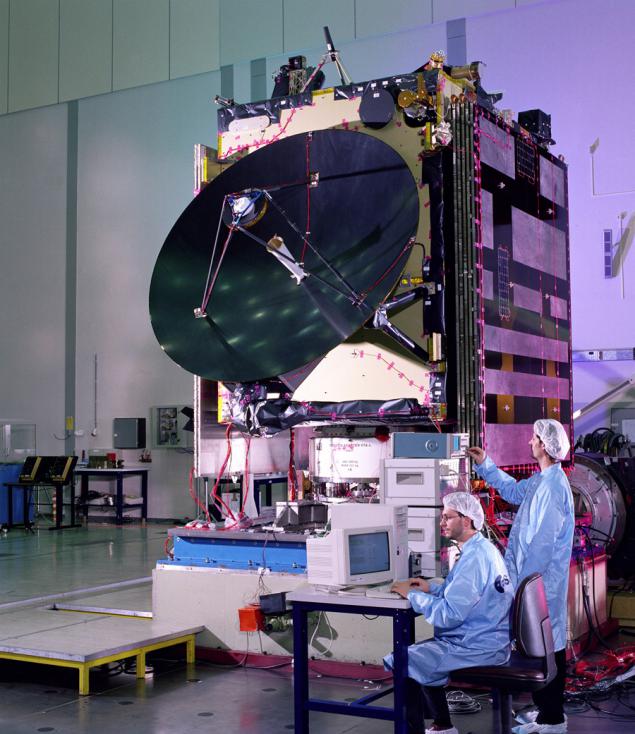
larger image
Comet Churyumov-Gerasimenko is not some unique cosmic body, requiring the compulsory study. On the contrary, it is an ordinary short-period comets, returning to the Sun every 6, 6 years old. It does not fly away on the orbit of Jupiter, but its trajectory is predictable and well turned up to the start window of the spacecraft. Rosetta previously planned for other comets, but problems with the launch vehicle was forced to delay the launch, so the goal changed.
Curious question - why the comet had to fly as much as ten years if it arrives more often? The reason for this - the scientific program Rosetta. All of the previous mission, since the US-Soviet and European ICE "Vega" in 80th, and ending Stardust in 2011, were on a collision course or span. For thirty years, scientists have been able to photograph the comet near the nucleus; could throw a comet metal bars, and a few years later to look at the result of the fall; could even bring back to Earth a little bit of cometary dust tail. But to spend close to the comet's nucleus for quite a long time, and to sit at her simple little meetings. Speed comets can reach tens and even hundreds of kilometers per second, this is added the second space of the device, so the "head" comet can only be planted bomb or Bruce Willis.
A long way to get close to allow Rosetta comet back and settle down next, following the same course and speed, and that (67P) Churyumov-Gerasimenko.
Along the way were filmed wonderful views of the Earth:
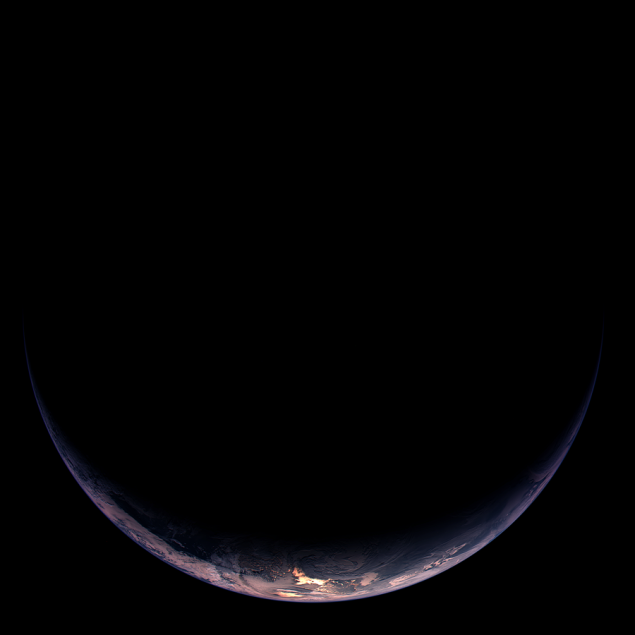
larger image .
On board the three-ton spacecraft is placed 12 scientific instruments that will study the temperature, composition, the rate of evaporation of the cometary tail, the surface of the nucleus. Radar experiment will make the radar "US" the comet nucleus to determine its internal structure. But the most interesting, in terms of showiness "pictures", expected results from the optical camera OSIRIS (Optical, Spectroscopic, and Infrared Remote Imaging System). This dual photo devices, equipped with two cameras with lenses 700 mm and 140 mm and a CCD-sensor 2048x2048 pixels.

During the time that Rosetta conducted in a way it was not idle, and implement a research program worthy of several independent missions. In general, it shows an example of how useful to have a spacecraft with a long-range camera, rushing back and forth across the solar system.
Eighteen months after the start of it from afar looked at the mission of NASA Deep Impact. Beat the impactor to comet Tempel 1 caused an outbreak, which is difficult to see through the eyes:

but it was registered more sensitive sensors:

Two years later, Rosetta flew in close proximity to Mars and made just gorgeous pictures of the planet in different spectral ranges. In the optical Mars looks like this:
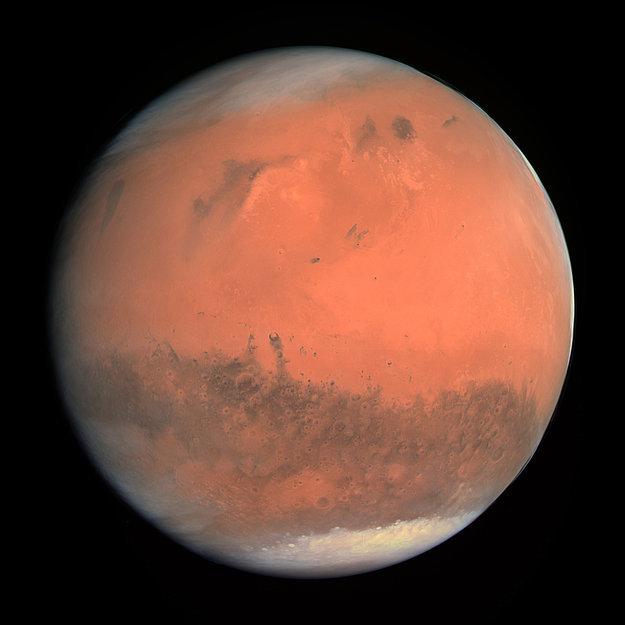
A UV channel it possible to distinguish details in the Martian atmosphere:
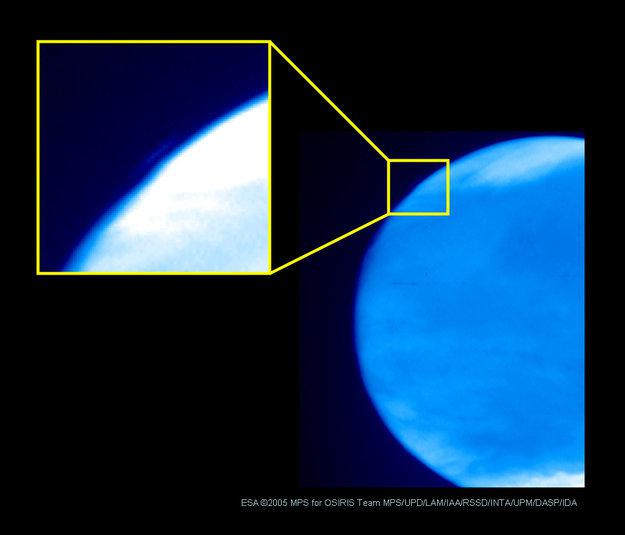
Separate managed to make a photo-board camera lander Philae:
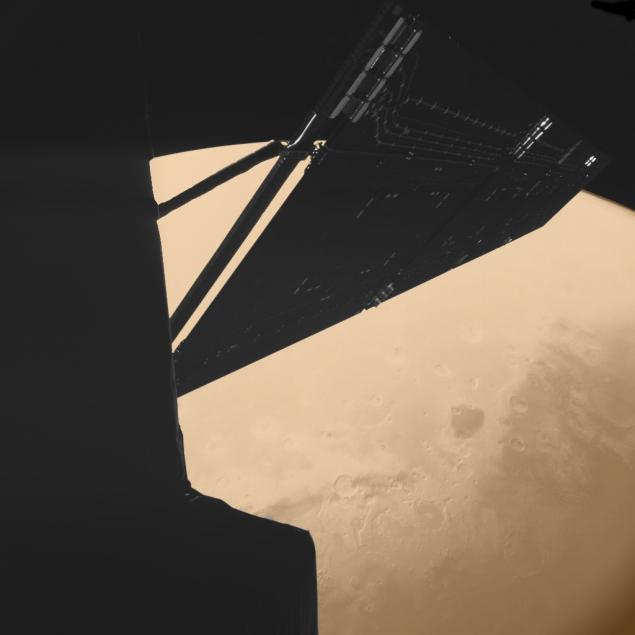
It is curious that, depending on the observed surface color camera can vary significantly. Such a pale beige color camera gave Mars satellite Mars Global Surveyor. (As it turned out , color is added artificially).
After Mars Rosetta "asleep" to wake up a half years in 2008 for shooting flying at a distance of 800 km six-kilometer asteroid Steins. True system failure prevented to shoot asteroid long-range camera, but allowed us to make wide-angle shots to within 80 meters per pixel, and get valuable data about the object.
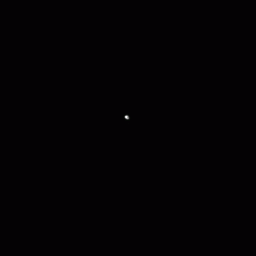
Even with the earth, it was determined that the asteroid relates to a class-E. Inspection at close range is confirmed. Steins turned consists of silicates to iron poor, but rich in magnesium, thus, some minerals heat transferred to 1000 degrees Celsius. Observations of the surface features of the asteroid's rotation and were able to confirm in practice YORP-effect. This effect occurs (more noticeable shown) of the irregularly shaped smaller asteroids. Uneven heating of the surface leads to the fact that the heated portion of the infrared radiation creates jet thrust which increases the rotational speed of the asteroid.
It is interesting that on the basis of the theory of YORP-effect, Steins had to take the form of a double cone, but a large impact crater at the south pole "splyusnul" Asteroids and gave it a form of "diamond". This is a blow, it seems, chopped in half the space body, but it continues to hold on to the forces of gravity, although scientists have considered signs of a giant crack, dissecting Steins.
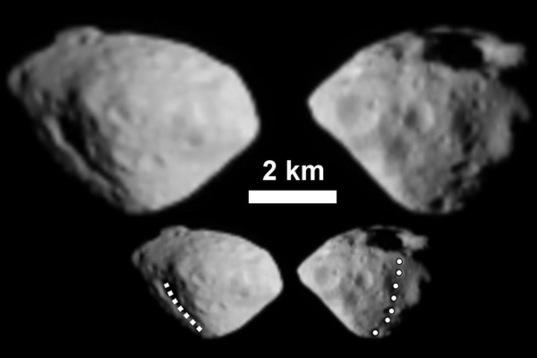
In spring 2010, Rosetta allowed to better identify a comet-like body of P / 2010 A2 detected in the asteroid belt. This "comet" created a sensation in the camp of astronomers in 2010, when it became absolutely not behave in the comet.

The picture of the telescope Hubble.
Despite the fact that the camera does not compare with Rosetta Hubble, observations made from a different angle will determine that this is not a comet, but the result of cosmic accident, when a 150-meter asteroid crashed into a small chip size of about one meter.
But the asteroid "star" of 2010 was (21) Lutetia. This stokilometrovy asteroid that examined Rosetta, a distance of 3170 km. At this time, 700 mm camera worked very well, so even from that distance turned out to remove surface features up to 60 meters per pixel.
Lutetia - this is a very interesting and mysterious object, whose research has raised many questions. Previously, astronomers have identified with the Earth as its spectral type M - asteroids with a lot of metal, while the spectral studies of Rosetta pointed rather to the class C - carbonaceous chondrites. Images of the surface led to the conclusion that Lutetia 3 km covered with a thick carpet of crushed regolith, hide bedrock. The analysis allowed us to determine its mass density: higher than the stone, but lower than that of metallic asteroid, which is also introduced in bewilderment. As a result, scientists have decided that we face is one of the few remaining from the date of birth of the solar system planetesimals - "planetary embryos".

larger image .
Once Lutetia began the process of differentiation of matter, moving the heavy metal rock in the center, and bring light stone - to the surface. However, she was too far away from the orbit of stone formation solar system planets and too close to Jupiter, whose gravitational perturbations are not allowed to dial the desired mass. Moreover, it is believed that the shape of Lutetia before approaching the area, but multiple collisions in the asteroid belt for 3, 5 billion. Years disfigured her appearance.
After inspecting the Lutetia Rosetta fell asleep again, only to wake up January 20, 2014. Now comes the test equipment and no problems have been identified, it seems a fantastic result for the spacecraft has spent ten years in the open space and twice pass through the asteroid belt.
What lies ahead? Make a note in your calendar.
May 2014: another important point for the mission - the last trajectory correction for a rapprochement with the comet. In late May, the distance between the "hunter and prey" will be about 100 thousand. Km. I think the time will come the first images of the comet and its nucleus. To Earth from them is still 450 million. Kilometers, so watch yourself comet will only powerful telescopes.
August 2014: Rosetta comet enters. Of course while in a coma. It is believed that the particles of dust and coma ice can damage the spacecraft, but in this case the opposing trajectories. For Rosetta comet speed will be almost zero, so that serious damage is not expected. But these days are expected most spectacular images of the approaching and rotating comet nucleus. If the camera will work normally, we will be able to see not only the surface of the nucleus, but also the processes that run on it, as you get closer to the sun. Gas and dust jets spurting out of the depths, should look just gorgeous.
November 2014: the busiest days, hours, minutes. There comes a close encounter with a comet 3km and resets the lander Philae. He should sit on the core, drill it, take a picture, enlighten radar, take soil samples ... In short, if the mission is successful, it will be a real triumph of interplanetary science.
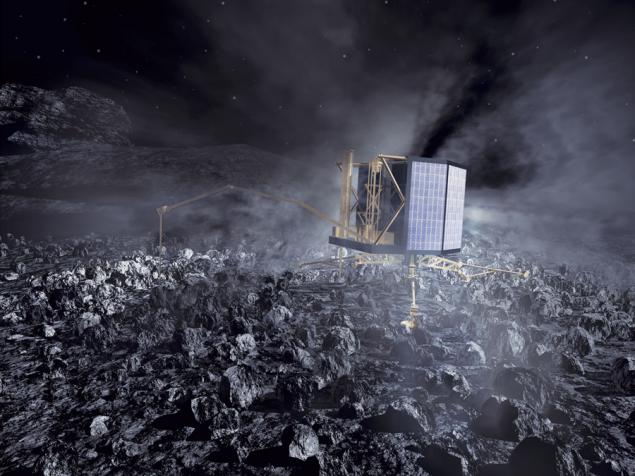
2015: Rosetta will continue to follow a comet as long as you can. Durability of Philae in question, much depends on the landing site, the mode of rotation of the nucleus, and surface conditions. During the approach to the sun it should be enough power to operate, but, as the removal efficiency of the battery will decrease. If you can sit down and stretch at least a month - it will be a boon for creators and for dozens of scientists in Europe and the United States.
Unfortunately the comet from the Earth is almost impossible to watch without serious art. Therefore, we can only wait, watch the news, and I wish good luck to the European Space Agency. Fly, Rosetta! Fly!
Source: habrahabr.ru/post/211444/

This summer and fall in space held the culmination of one of the most interesting research operations that are comparable in significance to the landing of the rover Curiosity - the implementation of a multi-year program of Rosetta. This spacecraft was launched in 2004 and the long ten years flying in the inner solar system, making adjustments and gravitational maneuvers, only to reach the orbit of the comet (67P) Churyumov-Gerasimenko. Rosetta comet should overtake, should be studied as a distance and landed lander Philae. He will hold its research part and together they tell us about comets as much as possible in a robotic mission.

larger image
Comet Churyumov-Gerasimenko is not some unique cosmic body, requiring the compulsory study. On the contrary, it is an ordinary short-period comets, returning to the Sun every 6, 6 years old. It does not fly away on the orbit of Jupiter, but its trajectory is predictable and well turned up to the start window of the spacecraft. Rosetta previously planned for other comets, but problems with the launch vehicle was forced to delay the launch, so the goal changed.
Curious question - why the comet had to fly as much as ten years if it arrives more often? The reason for this - the scientific program Rosetta. All of the previous mission, since the US-Soviet and European ICE "Vega" in 80th, and ending Stardust in 2011, were on a collision course or span. For thirty years, scientists have been able to photograph the comet near the nucleus; could throw a comet metal bars, and a few years later to look at the result of the fall; could even bring back to Earth a little bit of cometary dust tail. But to spend close to the comet's nucleus for quite a long time, and to sit at her simple little meetings. Speed comets can reach tens and even hundreds of kilometers per second, this is added the second space of the device, so the "head" comet can only be planted bomb or Bruce Willis.
A long way to get close to allow Rosetta comet back and settle down next, following the same course and speed, and that (67P) Churyumov-Gerasimenko.
Along the way were filmed wonderful views of the Earth:

larger image .
On board the three-ton spacecraft is placed 12 scientific instruments that will study the temperature, composition, the rate of evaporation of the cometary tail, the surface of the nucleus. Radar experiment will make the radar "US" the comet nucleus to determine its internal structure. But the most interesting, in terms of showiness "pictures", expected results from the optical camera OSIRIS (Optical, Spectroscopic, and Infrared Remote Imaging System). This dual photo devices, equipped with two cameras with lenses 700 mm and 140 mm and a CCD-sensor 2048x2048 pixels.

During the time that Rosetta conducted in a way it was not idle, and implement a research program worthy of several independent missions. In general, it shows an example of how useful to have a spacecraft with a long-range camera, rushing back and forth across the solar system.
Eighteen months after the start of it from afar looked at the mission of NASA Deep Impact. Beat the impactor to comet Tempel 1 caused an outbreak, which is difficult to see through the eyes:

but it was registered more sensitive sensors:

Two years later, Rosetta flew in close proximity to Mars and made just gorgeous pictures of the planet in different spectral ranges. In the optical Mars looks like this:

A UV channel it possible to distinguish details in the Martian atmosphere:

Separate managed to make a photo-board camera lander Philae:

It is curious that, depending on the observed surface color camera can vary significantly. Such a pale beige color camera gave Mars satellite Mars Global Surveyor. (As it turned out , color is added artificially).
After Mars Rosetta "asleep" to wake up a half years in 2008 for shooting flying at a distance of 800 km six-kilometer asteroid Steins. True system failure prevented to shoot asteroid long-range camera, but allowed us to make wide-angle shots to within 80 meters per pixel, and get valuable data about the object.

Even with the earth, it was determined that the asteroid relates to a class-E. Inspection at close range is confirmed. Steins turned consists of silicates to iron poor, but rich in magnesium, thus, some minerals heat transferred to 1000 degrees Celsius. Observations of the surface features of the asteroid's rotation and were able to confirm in practice YORP-effect. This effect occurs (more noticeable shown) of the irregularly shaped smaller asteroids. Uneven heating of the surface leads to the fact that the heated portion of the infrared radiation creates jet thrust which increases the rotational speed of the asteroid.
It is interesting that on the basis of the theory of YORP-effect, Steins had to take the form of a double cone, but a large impact crater at the south pole "splyusnul" Asteroids and gave it a form of "diamond". This is a blow, it seems, chopped in half the space body, but it continues to hold on to the forces of gravity, although scientists have considered signs of a giant crack, dissecting Steins.

In spring 2010, Rosetta allowed to better identify a comet-like body of P / 2010 A2 detected in the asteroid belt. This "comet" created a sensation in the camp of astronomers in 2010, when it became absolutely not behave in the comet.

The picture of the telescope Hubble.
Despite the fact that the camera does not compare with Rosetta Hubble, observations made from a different angle will determine that this is not a comet, but the result of cosmic accident, when a 150-meter asteroid crashed into a small chip size of about one meter.
But the asteroid "star" of 2010 was (21) Lutetia. This stokilometrovy asteroid that examined Rosetta, a distance of 3170 km. At this time, 700 mm camera worked very well, so even from that distance turned out to remove surface features up to 60 meters per pixel.
Lutetia - this is a very interesting and mysterious object, whose research has raised many questions. Previously, astronomers have identified with the Earth as its spectral type M - asteroids with a lot of metal, while the spectral studies of Rosetta pointed rather to the class C - carbonaceous chondrites. Images of the surface led to the conclusion that Lutetia 3 km covered with a thick carpet of crushed regolith, hide bedrock. The analysis allowed us to determine its mass density: higher than the stone, but lower than that of metallic asteroid, which is also introduced in bewilderment. As a result, scientists have decided that we face is one of the few remaining from the date of birth of the solar system planetesimals - "planetary embryos".

larger image .
Once Lutetia began the process of differentiation of matter, moving the heavy metal rock in the center, and bring light stone - to the surface. However, she was too far away from the orbit of stone formation solar system planets and too close to Jupiter, whose gravitational perturbations are not allowed to dial the desired mass. Moreover, it is believed that the shape of Lutetia before approaching the area, but multiple collisions in the asteroid belt for 3, 5 billion. Years disfigured her appearance.
After inspecting the Lutetia Rosetta fell asleep again, only to wake up January 20, 2014. Now comes the test equipment and no problems have been identified, it seems a fantastic result for the spacecraft has spent ten years in the open space and twice pass through the asteroid belt.
What lies ahead? Make a note in your calendar.
May 2014: another important point for the mission - the last trajectory correction for a rapprochement with the comet. In late May, the distance between the "hunter and prey" will be about 100 thousand. Km. I think the time will come the first images of the comet and its nucleus. To Earth from them is still 450 million. Kilometers, so watch yourself comet will only powerful telescopes.
August 2014: Rosetta comet enters. Of course while in a coma. It is believed that the particles of dust and coma ice can damage the spacecraft, but in this case the opposing trajectories. For Rosetta comet speed will be almost zero, so that serious damage is not expected. But these days are expected most spectacular images of the approaching and rotating comet nucleus. If the camera will work normally, we will be able to see not only the surface of the nucleus, but also the processes that run on it, as you get closer to the sun. Gas and dust jets spurting out of the depths, should look just gorgeous.
November 2014: the busiest days, hours, minutes. There comes a close encounter with a comet 3km and resets the lander Philae. He should sit on the core, drill it, take a picture, enlighten radar, take soil samples ... In short, if the mission is successful, it will be a real triumph of interplanetary science.

2015: Rosetta will continue to follow a comet as long as you can. Durability of Philae in question, much depends on the landing site, the mode of rotation of the nucleus, and surface conditions. During the approach to the sun it should be enough power to operate, but, as the removal efficiency of the battery will decrease. If you can sit down and stretch at least a month - it will be a boon for creators and for dozens of scientists in Europe and the United States.
Unfortunately the comet from the Earth is almost impossible to watch without serious art. Therefore, we can only wait, watch the news, and I wish good luck to the European Space Agency. Fly, Rosetta! Fly!
Source: habrahabr.ru/post/211444/
Ayers Rock
Satya Nadella officially became CEO of Microsoft. Bill Gates stepped down as Chairman of the Board of Directors


